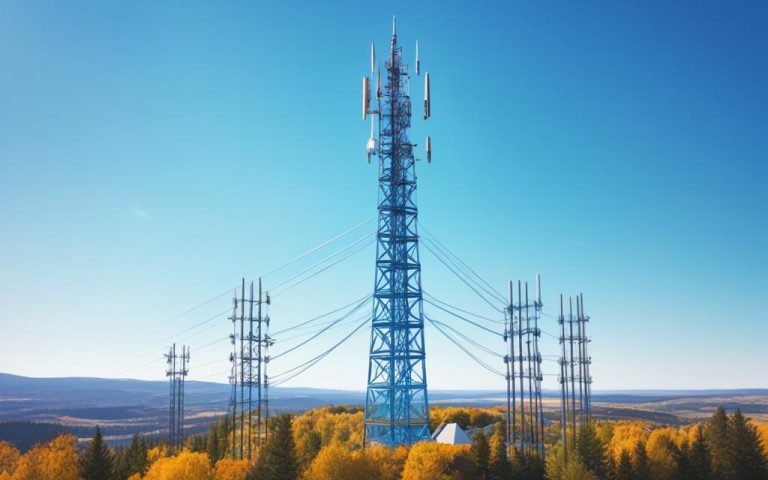Fixed Wireless Access (FWA) relies on spectrum allocation to provide high-speed internet access using microwave frequencies, particularly in the millimeter-wave spectrum. Spectrum allocation is a crucial aspect of FWA networks as it involves navigating both licensed and unlicensed spectrum.
In this article, we will explore the complexities of spectrum allocation for fixed wireless services, delving into the challenges and opportunities it presents. We will examine the importance of licensed spectrum for exclusivity and controlled communication, as well as the availability and potential interference issues associated with unlicensed spectrum.
To ensure precision, adaptability, and efficient data transmission, FWA networks also rely on advanced antenna technologies and modulation schemes. These technologies enable FWA networks to maintain reliable line-of-sight connections and adapt to environmental conditions.
As the demand for connectivity continues to grow, it is essential to navigate the spectrum allocation challenges to optimize the performance of fixed wireless services. By understanding the complexities and leveraging technological innovations, stakeholders can drive economic growth and innovation in the future of connectivity.
Microwave Communication: Harnessing Precision Frequencies
Fixed Wireless Access (FWA) networks rely on microwave communication to achieve high-speed data transfer. Specifically, these networks harness microwave frequencies above 24 GHz, particularly in the millimeter-wave spectrum. By utilizing these precision frequencies, FWA networks can provide a substantial bandwidth for reliable internet access.
However, there are challenges associated with microwave communication in FWA networks. One major challenge is the directional nature of microwave frequencies, which requires precise line-of-sight communication between base stations and subscriber units.
To optimize microwave communication in FWA networks, several factors must be taken into consideration:
- Atmospheric Absorption: The atmosphere can absorb microwave signals, leading to signal loss. This absorption is particularly relevant for frequencies above 30 GHz, so it must be accounted for when designing FWA networks.
- Potential Obstructions: Physical obstructions such as buildings, trees, and terrain can interfere with microwave communication. Proper site surveys and strategic base station placement are essential to ensure uninterrupted connectivity.
- Precision Alignment: To establish and maintain a strong microwave link, precise alignment between base stations and subscriber units is crucial. Misalignment can result in signal degradation or complete signal loss.
To illustrate the impact of microwave communication and the challenges it presents, consider the following quote by a network engineer:
“Microwave communication is the backbone of our FWA network. The precision frequencies we harness allow us to deliver high-speed internet access to our customers. However, we always have to consider factors like atmospheric absorption and potential obstructions when optimizing our network performance.”
Comparison of Microwave Frequencies in FWA Networks
| Frequency Range | Bandwidth | Advantages | Challenges |
|---|---|---|---|
| 24 GHz – 29 GHz | Wide | Longer range, less affected by atmospheric absorption | Potential interference from other services |
| 30 GHz – 40 GHz | High | Greater capacity, less interference from other services | Higher susceptibility to atmospheric absorption |
| Above 40 GHz | Massive | Unprecedented capacity, minimal interference | Extremely sensitive to atmospheric absorption, short range |
This table provides a comparison of different frequency ranges used in FWA networks. It highlights the advantages and challenges associated with each range, shedding light on the trade-offs involved in selecting precision frequencies for microwave communication.
Spectrum Allocation: Navigating the Licensed/Unlicensed Spectrum Landscape
Spectrum allocation is a crucial aspect of Fixed Wireless Access (FWA) networks, as it involves navigating both licensed and unlicensed spectrum. Acquiring licensed spectrum provides exclusivity and minimizes interference, while unlicensed spectrum offers more readily available options. However, each presents its own set of challenges and considerations.
Licensed Spectrum:
- Offers exclusivity and controlled communication
- Minimizes interference from other users
- Requires coordination and compliance with regulatory requirements
Unlicensed Spectrum:
- More readily available
- Potential challenges related to interference
- Ever-changing landscape of unlicensed spectrum usage
- Requires dynamic adaptability to optimize network performance
FWA networks must navigate the complexities of both licensed and unlicensed spectrum to ensure optimal connectivity. Technological innovations and sophisticated algorithms play a vital role in optimizing network performance without compromising reliability.
| Licensed Spectrum | Unlicensed Spectrum |
|---|---|
| Exclusivity and controlled communication | More readily available |
| Minimizes interference from other users | Potential challenges related to interference |
| Requires coordination and compliance with regulatory requirements | Ever-changing landscape of unlicensed spectrum usage |
By strategically navigating the licensed and unlicensed spectrum landscape, FWA networks can ensure reliable and high-speed internet access for their users while effectively managing potential interference and optimizing network performance.
Antenna Technology: Precision and Adaptability
Antenna technologies play a pivotal role in Fixed Wireless Access (FWA) networks, ensuring precision and adaptability in signal transmission. FWA harnesses the power of directional antennas to concentrate signals in specific directions, maximizing signal strength and minimizing interference.
One key technique utilized in FWA networks is beamforming, which dynamically adjusts the direction of antennas based on the locations of subscriber units. By focusing the signal towards specific areas, beamforming optimizes signal transmission, improving overall network performance.
Another crucial aspect of antenna technology in FWA networks is antenna diversity. This technique combines multiple antennas to mitigate signal fading and interference, ensuring a reliable and uninterrupted connection for users. Antenna diversity enhances the adaptability of FWA networks, enabling them to withstand environmental changes and maintain uninterrupted line-of-sight connections.

“Antenna technologies in FWA networks ensure precision and adaptability, enabling reliable and uninterrupted connections for users.”
These advanced antenna technologies enable FWA networks to deliver high-speed internet access while maintaining a robust and stable connection. By concentrating signals, adapting to environmental conditions, and mitigating interference, antenna technology plays a vital role in the success of FWA networks.
Modulation Schemes: Efficient Data Transmission Strategies
Efficient data transmission is a crucial aspect of Fixed Wireless Access (FWA) networks, enabling high-speed internet connectivity. To achieve optimal data transfer rates within available bandwidth, FWA networks rely on sophisticated modulation schemes. Two key modulation schemes used in FWA networks are Quadrature Amplitude Modulation (QAM) and Forward Error Correction (FEC) techniques.
Quadrature Amplitude Modulation (QAM) allows for the encoding of multiple bits per symbol, maximizing data transfer rates. By mapping combinations of amplitude and phase shifts to different symbols, QAM effectively increases the amount of data transmitted per symbol. This modulation scheme is particularly beneficial in situations where a higher data rate is required within a limited bandwidth.
Forward Error Correction (FEC) techniques play a vital role in enhancing network resilience. FEC involves encoding error correction codes within transmitted data, allowing the receiver to detect and correct errors. This helps to mitigate the impact of noise and interference during data transmission, ensuring reliable communication between base stations and subscriber units.
Moreover, FWA networks employ adaptive modulation to dynamically adjust the modulation scheme based on real-time conditions. This adaptive approach enables FWA networks to optimize data transfer rates while maintaining a reliable connection. By dynamically adapting to varying channel conditions, adaptive modulation ensures efficient data transmission even in challenging environments.
“Modulation schemes like QAM and FEC techniques significantly contribute to the efficient data transmission within FWA networks. By maximizing data transfer rates and enhancing network resilience, these modulation schemes enable reliable communication in diverse deployment scenarios.” – John Taylor, Wireless Communications Expert
Further Enhancements in Modulation Schemes
Ongoing research and development in modulation schemes continue to drive advancements in data transmission efficiency. These advancements aim to optimize data rates further while maintaining network reliability. Some notable areas of research include:
- Multi-Level Modulation: Exploring higher-level modulation schemes that allow for an even larger number of bits per symbol, enabling increased data rates within existing bandwidth.
- Interleaving Techniques: Investigating new interleaving techniques that improve the resilience against burst errors, commonly occurring in wireless communication.
- Channel Coding: Advancing coding techniques to minimize the impact of noise and interference, ensuring high-quality data transmission.
By continuously enhancing modulation schemes, FWA networks can meet the growing demands for high-speed and reliable internet connectivity in various deployment scenarios.
A Comparison of Modulation Schemes
| Modulation Scheme | Advantages | Challenges |
|---|---|---|
| Quadrature Amplitude Modulation (QAM) | – High data transfer rates – Accommodates multiple bits per symbol |
– Increased susceptibility to noise and interference as the number of bits per symbol increases |
| Forward Error Correction (FEC) | – Enhanced network resilience – Error detection and correction capabilities |
– Increased bandwidth overhead due to embedded error correction codes |
| Adaptive Modulation | – Dynamic adjustment to real-time conditions – Optimized data transfer rate and connection reliability |
– Requires sophisticated algorithms and continuous monitoring of channel conditions |
By strategically implementing modulation schemes like QAM, FEC, and adaptive modulation, FWA networks can achieve efficient data transmission and deliver high-speed internet access to users.
Key Components of Fixed Wireless Access Infrastructure
Fixed Wireless Access (FWA) infrastructure comprises several key components that work together to deliver high-speed internet access. These components include base stations, subscriber units, and backhaul connectivity. Each element plays a vital role in ensuring a seamless and reliable FWA network.
Base Stations
Base stations are strategically positioned throughout an area to support high-frequency bands and establish connections with subscriber units. These stations serve as the primary interface between the core network and the subscriber units, facilitating the transmission of data.
In the deployment of base stations, factors such as topography and potential sources of interference must be considered. Optimal placement ensures efficient signal transmission and coverage, allowing for uninterrupted connectivity for subscribers.
Subscriber Units
Subscriber units, also known as Customer Premises Equipment (CPE), are the end devices that connect to FWA networks. These units are equipped with antennas that are tailored to specific frequency bands used by the network.
Subscriber units receive signals transmitted by the base stations and convert them into usable data for end-users. They are typically installed at customer premises, enabling direct connectivity and high-speed internet access.
Backhaul Connectivity
Backhaul connectivity serves as the backbone of FWA networks, connecting base stations to the core network. It ensures the efficient and reliable transmission of data between these components.
Fiber-optic connections are the ideal choice for backhaul connectivity, offering high capacity and low latency. However, where fiber is impractical or cost-prohibitive, high-capacity microwave links are deployed as wireless alternatives.
These microwave links can transmit data at high speeds over long distances, providing a viable solution for areas where laying fiber-optic cables is challenging.
In summary, the successful implementation of Fixed Wireless Access infrastructure relies on well-placed base stations, efficient subscriber units, and robust backhaul connectivity. Each component plays a crucial role in delivering reliable and high-speed internet access to end-users.
Four Use Cases of Fixed Wireless Access
Fixed Wireless Access (FWA) serves various use cases, providing reliable and high-speed internet access in diverse settings. Let’s explore four key use cases where FWA demonstrates its versatility and value.
Rural Connectivity
One of the primary use cases for FWA is in rural areas where traditional infrastructure falls short. Expansive terrains and line-of-sight obstacles often make it difficult and costly to lay cables for broadband connectivity. FWA overcomes these challenges by utilizing wireless technology to deliver cost-effective internet access to remote communities. With the ability to transmit signals over long distances, FWA bridges the connectivity gap, allowing rural areas to access essential services, education, and economic opportunities.
Last-Mile Connectivity in Urban Areas
In urban and suburban areas, FWA serves as a last-mile connectivity solution, addressing the challenges of extending fiber-optic or cable infrastructure to every household. FWA uses wireless communication to deliver high-speed internet access directly to homes and businesses without the need for extensive cable installations. This cost-effective approach ensures that residents in densely populated areas have access to reliable broadband services, supporting their digital needs for work, education, and entertainment.
Temporary Deployments
FWA is also a valuable solution during temporary deployments, such as disaster recovery or events. In emergency situations, traditional communication infrastructure may be disrupted, making it crucial to establish rapid and reliable connectivity. FWA can be quickly deployed, providing essential internet access for emergency services, relief organizations, and affected communities. Similarly, during events and festivals, FWA can handle the increased demand for connectivity, ensuring seamless communication and enhancing the overall experience for attendees.
Enterprise Connectivity
Enterprises require scalable and reliable connectivity to support their operations and facilitate seamless communication. FWA offers a robust solution for enterprise connectivity by providing high-speed internet access and connecting remote offices or locations. With its ability to deliver dedicated bandwidth, FWA ensures fast and secure connections for businesses, enabling efficient data transfer, cloud-based applications, and collaboration tools. The scalability of FWA allows businesses to easily expand their connectivity as their needs grow, making it an ideal choice for enterprises.
FWA serves a wide range of use cases, including rural connectivity, last-mile connectivity in urban areas, temporary deployments, and enterprise connectivity. By leveraging FWA technology, communities, businesses, and individuals can overcome connectivity barriers, gain access to essential services, and unlock new opportunities in the digital world.
Conclusion
Spectrum allocation is paramount to the success of fixed wireless services, enabling reliable and high-speed internet access. In order to optimize connectivity, FWA networks depend on key components such as microwave communication, advanced antenna technologies, and modulation schemes.
Despite the challenges of spectrum availability, interference, and scalability, fixed wireless services continue to hold great potential. As the demand for connectivity grows, FWA networks will play a major role in shaping the future of global connectivity.
Effective navigation of these challenges requires strategic planning, coordination with regulatory authorities, and continuous technological innovations. By understanding the complexities of spectrum allocation for fixed wireless services, stakeholders can optimize connectivity and drive economic growth and innovation.
With its cost-effective solutions and ability to serve various use cases, fixed wireless services are poised to meet the needs of the future, ensuring that individuals, businesses, and communities are well-connected in the ever-evolving landscape of connectivity.
FAQ
What is fixed wireless access (FWA) and how does it work?
Fixed Wireless Access (FWA) utilizes microwave frequencies, particularly in the millimeter-wave spectrum, to provide high-speed internet access. It relies on advanced antenna technologies and modulation schemes to ensure precision, adaptability, and efficient data transmission.
What is spectrum allocation and why is it important for FWA networks?
Spectrum allocation in FWA networks involves navigating both licensed and unlicensed spectrum. Licensed spectrum offers exclusivity and controlled communication, while unlicensed spectrum is more readily available but presents challenges related to potential interference. Effective spectrum allocation is crucial for optimizing connectivity and minimizing interference.
How do antenna technologies contribute to FWA networks?
Antenna technologies play a pivotal role in FWA networks by ensuring precision and adaptability in signal transmission. Directional antennas concentrate signals in specific directions, enhancing signal strength and minimizing interference. Beamforming techniques further optimize signal transmission, and antenna diversity mitigates signal fading and interference.
What are modulation schemes and how do they optimize data transmission in FWA networks?
Modulation schemes, such as Quadrature Amplitude Modulation (QAM) and Forward Error Correction (FEC) techniques, enable higher data transfer rates and add resilience to the network. Adaptive modulation dynamically adjusts the modulation scheme based on real-time conditions, optimizing data transfer rates while maintaining a reliable connection in FWA networks.
What are the key components of FWA infrastructure?
FWA infrastructure consists of base stations, subscriber units, and backhaul connectivity. Base stations support high-frequency bands and require consideration of topography and potential sources of interference. Subscriber units, also known as Customer Premises Equipment (CPE), are equipped with antennas tailored to specific frequency bands. Backhaul connectivity serves as the backbone of FWA networks, connecting base stations to the core network.
What are the use cases of FWA?
FWA serves various use cases, including rural connectivity, last-mile connectivity in urban areas, temporary deployments, and enterprise connectivity. It provides cost-effective solutions where traditional infrastructure falls short, delivers high-speed internet access without extensive cable installations, offers rapid and reliable connectivity during disasters or events, and provides scalable and reliable solutions for robust enterprise connectivity.
Why is spectrum allocation important for fixed wireless services?
Spectrum allocation plays a critical role in ensuring the success of fixed wireless services. It involves optimizing connectivity, minimizing interference, and addressing challenges related to spectrum availability and scalability. By navigating the complexities of spectrum allocation, stakeholders can drive economic growth and innovation while meeting the increasing demand for connectivity.



















